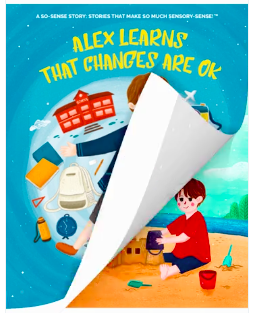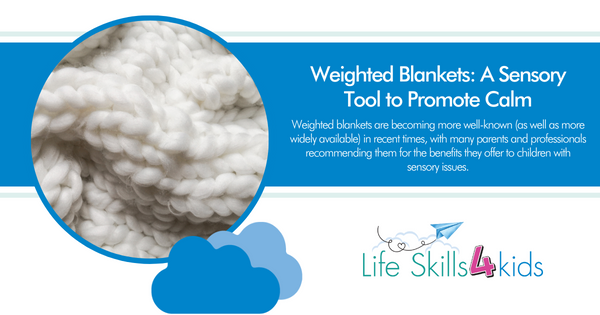Weighted blankets are becoming more well-known (as well as more widely available) in recent times, with many parents and professionals recommending them for the benefits they offer to children with sensory issues.
But do they live up to their reputation? Let’s dive in and take a look at the pros and cons.
Weighted blankets and sensory issues: What’s the hype about?
Children who have sensory issues often struggle with emotional regulation and self-calming. The majority of children with ADHD or autism also have sensory issues, with an array of sensory triggers that make self-soothing or emotional regulation difficult.
The parents of children who experience these challenges report that for many, using a weighted blanket helps to bring back the calm and assists with self-regulation. Professionals such as occupational therapists also recommend using weighted blankets as a sensory modulation tool for some children.
A word on sensory processing disorder
Sensory Processing Disorder (SPD) can occur independently of autism and ADHD, but they frequently go together.
People who do not have SPD can find loud noises, bright lights, or the wrong touch pressure irritating, but that’s the extent of the problem for them. People with SPD find the same things unbearable, to the point that their bodies can react physically, such as breaking out into a sweat or feeling nauseous.
SPD can also include the opposite end of the scale (hyposensitivity) when people with the disorder fail to perceive sensory stimuli as intensely. An example of this would be touching something hot; the normal response is to pull away quickly as the brain tells the body to avoid further harm. However, a hyposensitive person may not notice the sensation and may suffer more harm as a result.
Researchers tell us that the cause is a “neurological traffic jam,” meaning that the brain is unable to efficiently process the sensory signals it receives. The information gets jammed or jumbled and results in an inability to process stimuli from the outside world.
What does the science say?
Scientific studies of the effectiveness of weighted blankets are sparse. There is cautious acceptance of the possible advantages they offer, but more research is needed to quantify the benefits.
That said, there is plenty of anecdotal evidence from parents and professionals that they are a worthwhile investment for some children with SPD.
The risks: Some people shouldn’t use them
Weighted blankets are not for everyone as they come with risks. Babies and children under the age of four shouldn’t use them due to the risk of suffocation, overheating, and SIDS. They should only be used by older children or people who can remove them during the night.
People with limited mobility should not use them, along with anyone who is physically weak. Likewise, people with sleeping disorders such as sleep apnoea should avoid them, and they are not safe for people with epilepsy, heart conditions, skin conditions, or circulation problems.
Do weighted blankets help with anxiety?
Limited research suggests that they do help with anxiety, and anecdotal evidence from parents and professionals backs up this claim. It appears that they promote calm by increasing feel-good hormones such as dopamine and serotonin, which helps to reduce stress hormones such as cortisol.
How to choose a weighted blanket
Weighted blankets are filled with “stuffers” to achieve the sense of a firm hug or massage. It’s important to choose a good quality blanket from a reputable supplier to negate the risk of the stuffing coming out and presenting a choking hazard.
Many professionals recommend a blanket that is around 10% of the user’s body weight to achieve the right touch balance.
The only way to really know if a weighted blanket will work for your child is to try it. Some children will respond well, and a weighted blanket is a great solution for sleep issues or anxiety, while it doesn’t work at all for others. As frustrating as that might be, each child has individual needs, and it’s often a matter of trial and error to find something that works.
How to use a weighted blanket
Each child is different and has different touch needs. Some prefer deep pressure touch, while others dislike it. So a weighted blanket is not for every child, but it can help with getting to sleep, calming down while doing something else such as watching TV or reading a book, or self-regulating emotions.
To use a weighted blanket safely, children should not be left unattended when asleep. The blanket should be removed around twenty minutes after falling asleep, and it should never be pulled up around the child’s face or any higher than the shoulders.
Is a weighted blanket the right solution for your child?
There are solutions to every problem, and sensory issues in children are no exception. For more information and helpful tips, head over to my website, www.lifeskills4kids.com.au, where you will find lots of resources to help guide you with the right solutions for your child.
Alex Learns That Changes Are OK
Alex loves school. He enjoys all the activities he does during the term such as swimming and soccer. He also loves holidays and all the fun things he gets to do while he’s not at school. The problem is, Alex doesn’t like changes. His tummy gets all tight and he gets a worry cloud that comes over his brain and makes it feel foggy. When the school term ends and holidays begin or when school is about to start again, Alex feels really worried and anxious.
Alex’s Mum doesn’t want him to worry. So she does some reading and finds a really cool trick that helps Alex to feel comfortable with changes. It works! Alex is able to keep his worries under control and think about all the fun things that are coming up instead. Can you guess what Alex’s special trick is.
Alex Learns that Changes Are Okay is a beautiful book for children who find change difficult.
When you purchase the Alex Learns that Changes are OK (Flipbook), you will receive a digital flipbook that gradually changes from one page to the next while listening to high-quality audio narration as if someone is flipping and reading the book for you!


